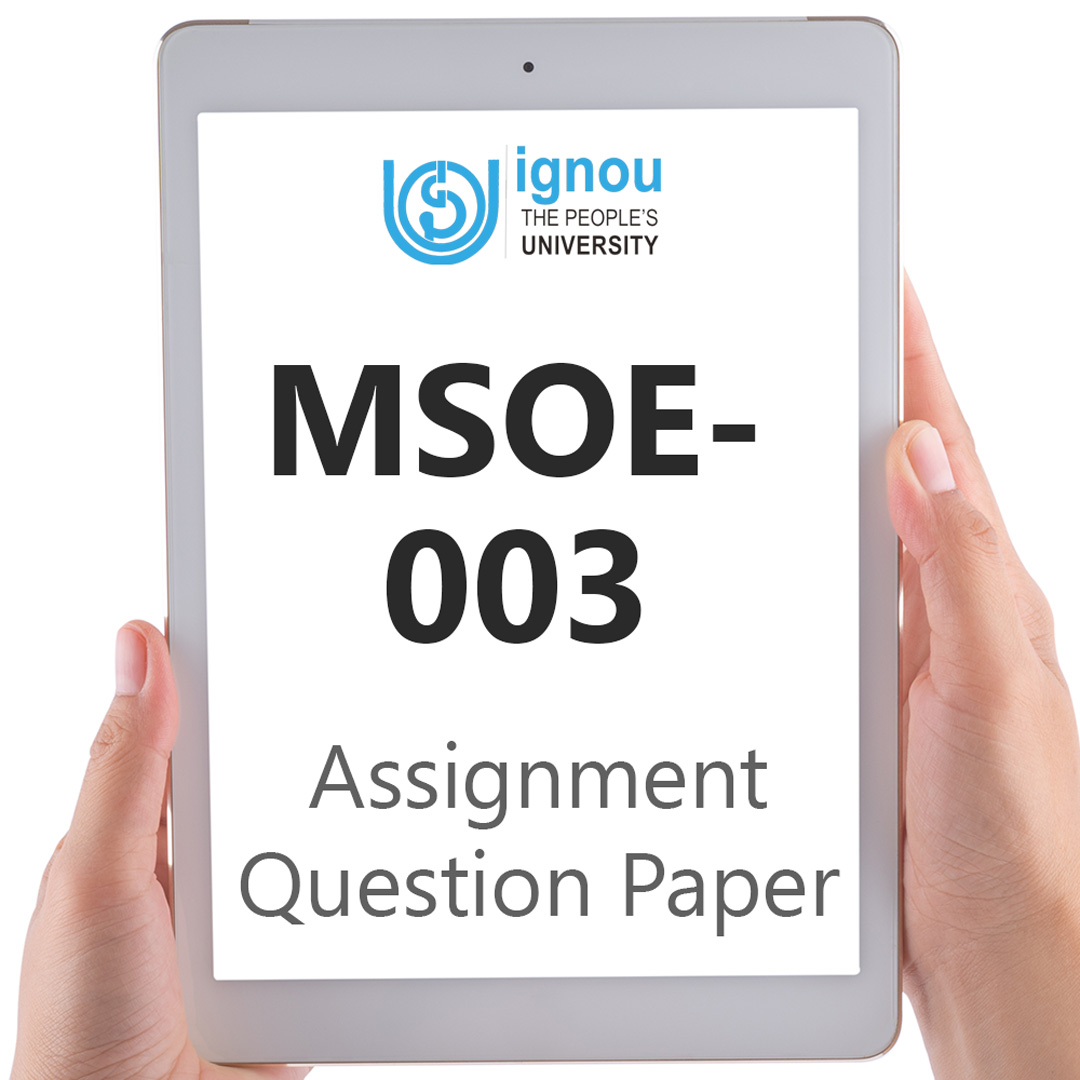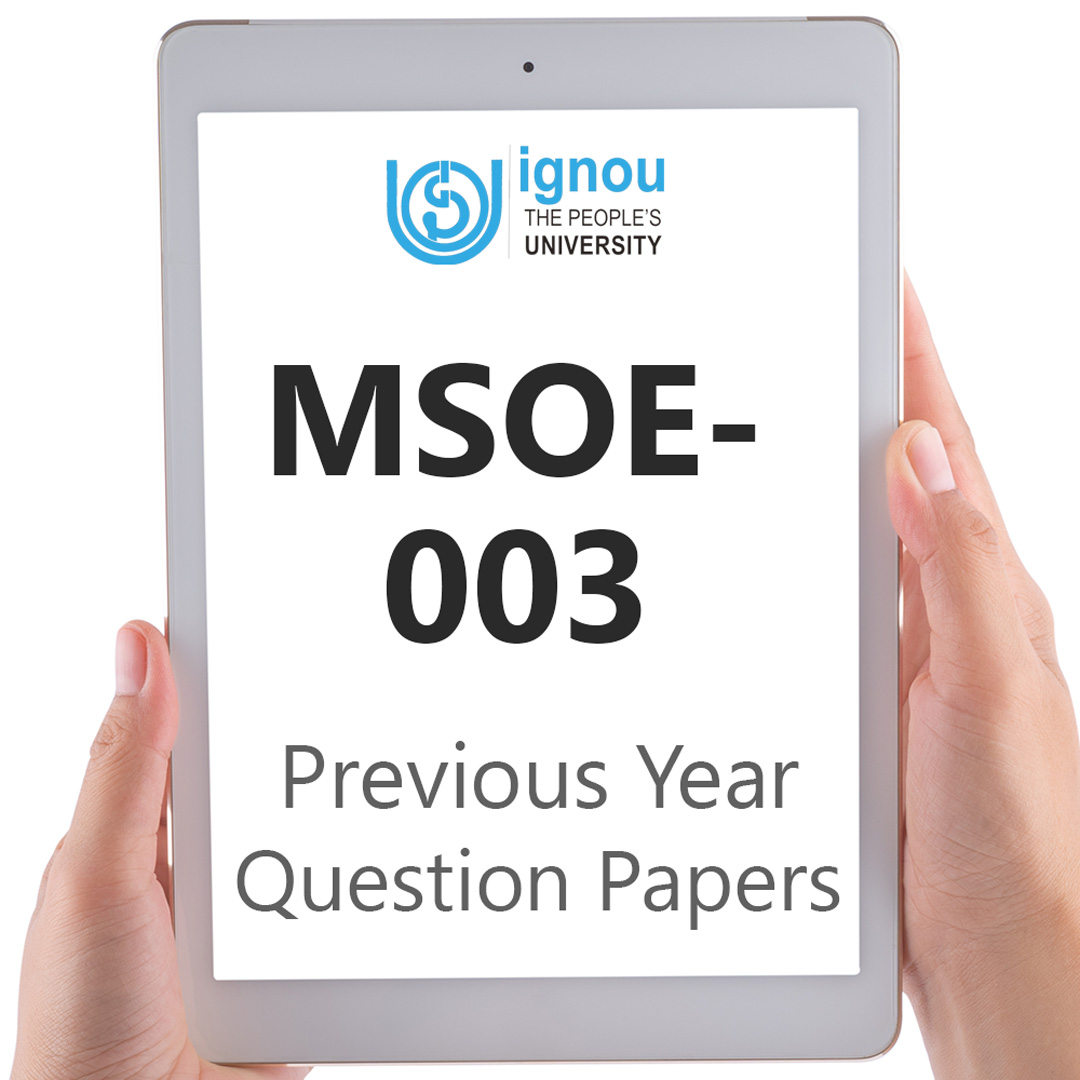If you are looking for MSOE-003 IGNOU Solved Assignment solution for the subject Sociology of Religion, you have come to the right place. MSOE-003 solution on this page applies to 2023-24 session students studying in MSO courses of IGNOU.
MSOE-003 Solved Assignment Solution by Gyaniversity
Assignment Code: MSOE-003/AST/TMA/2022-2023
Course Code: MSOE-003
Assignment Name: Sociology of Religion
Year: 2022-2023
Verification Status: Verified by Professor
Answer any five questions selecting at least two from each Section. Your answer should be in about 500 words each.
Section-I
Q1) Discuss the functional interpretation of religion.
Ans) The functional interpretation of religion views it as serving specific functions within society rather than focusing solely on its spiritual or theological aspects. This perspective, often associated with sociological studies, emphasizes the role religion plays in maintaining social order, coherence, and stability.
Several key points are highlighted within this interpretation:
a) Social Cohesion: Religion serves as a unifying force that brings individuals together under a common set of beliefs, rituals, and values. It strengthens the sense of community and solidarity among its followers.
b) Normative Framework: It provides a moral and ethical framework that guides individual behaviour and societal norms. Religious teachings often offer guidelines for personal conduct, family values, and social ethics.
c) Social Control: Religious institutions often reinforce societal norms and values, acting as a mechanism of social control. They regulate behaviour by sanctioning certain actions and discouraging others through moral teachings and religious laws.
d) Social Integration: Religion facilitates integration by providing rituals and ceremonies that mark important life events like birth, marriage, and death. These rituals reinforce social bonds and provide a sense of continuity within a community.
e) Psychological Support: It offers emotional and psychological support to individuals during times of crisis, providing comfort, hope, and meaning, which can be especially crucial during challenging situations.
f) Legitimization of Authority: Religion often supports and legitimizes existing power structures, political systems, and social hierarchies by endorsing the status quo and justifying authority.
g) Adaptation to Change: Religion can also adapt to social changes by modifying interpretations of religious texts or traditions, thereby maintaining relevance in evolving societies.
Functionalists, such as Émile Durkheim, Max Weber, and Talcott Parsons, emphasized the role of religion in promoting social stability and cohesion. However, critics argue that this perspective may oversimplify the complexities of religion by focusing primarily on its positive functions, sometimes overlooking its potential for conflict, division, and oppression within societies.
Overall, the functional interpretation of religion underscores its significance in fostering social order, coherence, and stability, highlighting its multifaceted role in shaping individual behaviour and societal dynamics.
Q2) Explain the concept of sacrifice with reference to Nuer society.
Ans) In Nuer society, sacrifice holds a significant cultural and symbolic importance, particularly in the context of their religious and communal practices. The Nuer, a pastoral community living in South Sudan and Ethiopia, have a complex system of beliefs and rituals that revolve around the concept of sacrifice.
a) Rituals and Symbolism: Sacrifice among the Nuer involves the offering of animals, such as cattle, goats, or sheep, to the spirits or deities as a form of communication. This act is believed to establish a connection between the human and spirit worlds.
b) Religious Significance: Sacrificial rituals are performed during important events like weddings, funerals, initiations, or to address issues such as illness, drought, or conflict. Sacrifices are made to appease the spirits, seek their blessings, or address concerns affecting the community.
c) Social Cohesion: Sacrificial ceremonies serve as a means of social cohesion within the Nuer community. These rituals reinforce social ties, strengthen kinship bonds, and unify community members through shared participation in religious practices.
d) Spiritual Communication: Sacrifice is seen as a form of communication with the spiritual realm. It is believed that through these offerings, individuals can convey their intentions, seek protection, or express gratitude to the spirits or ancestors.
e) Resource Redistribution: Sacrifice involves the redistribution of valuable resources like livestock within the community. By sacrificing animals, wealth is shared among community members, reinforcing reciprocal relationships and social harmony.
f) Identity and Tradition: Sacrificial practices are deeply embedded in Nuer identity and tradition. They are a way of affirming cultural heritage, passing down ancestral beliefs, and reinforcing the significance of customary practices.
The act of sacrifice among the Nuer is multifaceted, serving religious, social, and cultural purposes. It embodies their beliefs in the spiritual world, reinforces community cohesion, and acts as a means of communication with the divine. Sacrifice plays a crucial role in shaping the Nuer worldview, social structures, and communal identity.
Section-II
Q3) Explain religion as a system of symbols.
Ans) Religion as a system of symbols refers to the idea that religious beliefs, rituals, and practices are structured around a set of symbolic representations that convey deeper meanings and significance within a particular religious context. This perspective, often associated with scholars like Clifford Geertz, emphasizes the symbolic nature of religion and how symbols shape religious experiences and meaning-making for believers. Here's an exploration of this concept:
a) Symbolism in Religion: Symbols are elements or objects that represent abstract ideas, values, or beliefs. In religion, symbols can include rituals, myths, sacred texts, artifacts, or even natural elements like water, fire, or specific animals. These symbols carry meanings that go beyond their literal or physical existence.
b) Interpreting Symbolic Meanings: According to this perspective, understanding religion involves interpreting these symbols and their meanings within the cultural and social contexts in which they are embedded. For instance, a religious ritual might symbolize purification, rebirth, or communal unity, carrying profound significance for believers.
c) Religious Rituals and Myths: Religious rituals, such as prayers, sacrifices, or ceremonies, are laden with symbolic elements. These rituals are not merely practical or performative but are rich in symbolic actions and meanings. Similarly, myths and narratives within religious texts are understood as symbolic stories that convey deeper truths about existence, morality, or cosmology.
d) Expressing and Reinforcing Beliefs: Symbols in religion help express and reinforce religious beliefs, values, and identities. They offer believers a framework to understand their relationship with the divine, their community, and the world around them. For example, religious symbols might represent the sacred, the transcendent, or moral principles.
e) Cultural and Social Significance: Beyond individual belief, religious symbols have cultural and social significance. They shape collective identities, rituals, and norms within a religious community. Symbols often serve as a unifying force, creating a shared understanding and sense of belonging among adherents.
f) Implications for Interpretation: Understanding religion as a system of symbols requires a nuanced interpretation of religious practices and texts. Scholars and anthropologists approach religious phenomena by exploring the meanings attached to symbols within specific cultural contexts, acknowledging the diverse interpretations and nuances of religious symbolism.
Viewing religion through the lens of symbols highlights the symbolic dimensions of religious life, emphasizing the intricate relationship between symbols, meanings, and the cultural fabric of religious belief systems.
Q4) Explain the European concept of secularism.
Ans) The European concept of secularism, often traced back to the Enlightenment period and the subsequent process of modernization, centers on the separation of religious institutions from the functions of the state and public life. It's characterized by several key elements:
a) Separation of Church and State: European secularism advocates for the independence of religious institutions from state interference and vice versa. It ensures that governments do not favour any particular religion and refrain from interfering in religious affairs.
b) Religious Neutrality: Secularism in Europe promotes a stance of religious neutrality by governments and public institutions. It entails treating all religions (or the lack thereof) equally, ensuring that laws, policies, and public services are not based on or biased toward any specific religious belief.
c) Freedom of Religion and Belief: European secularism upholds the freedom of individuals to practice their faith or choose not to follow any religion. It includes the freedom to worship, the right to change or leave one's religion, and the freedom to express religious beliefs or opinions within the bounds of law and public order.
d) Public Sphere and Private Faith: Secularism encourages the relegation of religious beliefs to the private sphere, separating them from public policy and governance. It promotes the idea that religious beliefs and practices are personal matters that should not unduly influence public decision-making.
e) Education and Institutions: European secularism emphasizes the secularization of education and public institutions. It advocates for the provision of education that is free from religious indoctrination and the administration of public services without religious biases.
f) Pluralism and Tolerance: Secularism in Europe aligns with values of pluralism and tolerance, fostering a society where diverse religious and non-religious perspectives coexist peacefully, respecting each other's rights and freedoms.
The European concept of secularism varies across countries due to historical, cultural, and social differences. Some European nations have adopted more stringent secular policies, while others have accommodationist approaches, allowing for state support of religious institutions in certain contexts. Additionally, the interpretation and application of secularism can spark debates regarding the limits of religious expression in public life, such as the wearing of religious symbols in schools or workplaces.
Q5) Examine the social context of the emergence of Buddhism.
Ans) The emergence of Buddhism in ancient India was deeply intertwined with the socio-political and religious landscape of that era. Here are some key social contexts that contributed to the rise of Buddhism:
a) Vedic Society and Brahmanical Dominance:
Ancient India was predominantly influenced by the Vedic traditions and the supremacy of Brahmanism, which formed the basis of society's structure and rituals.
The authority and privileges of the Brahmin priests were central to the Vedic society. The ritualistic and complex nature of Vedic sacrifices led to a hierarchical social structure.
b) Social Discontent and Dissatisfaction:
The Vedic society was marked by social stratification and the domination of certain classes, especially the Brahmins, over others. The caste system, with its rigidity and discrimination, led to discontent among various social groups, including the lower castes and women, who were marginalized and excluded from religious practices and social privileges.
c) Seeking Liberation and Ascetic Movements:
Many individuals sought liberation (moksha) from the cycle of birth and rebirth (samsara) and questioned the efficacy of Vedic rituals in achieving spiritual enlightenment.
Ascetic movements emerged as a response to the prevailing social and religious norms. Ascetics renounced worldly pleasures and rituals in pursuit of spiritual truth.
d) Life of Siddhartha Gautama (Buddha):
Siddhartha Gautama, later known as the Buddha, was born into a noble family in the Shakya clan. His exposure to suffering, old age, sickness, and death led him to renounce his princely life and seek enlightenment.
His teachings focused on the Four Noble Truths and the Eightfold Path, emphasizing the cessation of suffering (dukkha) and the importance of compassion and ethical conduct.
e) Appeal to the Masses:
Buddhism emphasized equality and rejected the caste system prevalent in society. It welcomed people from all backgrounds, regardless of caste, into its fold.
The teachings of Buddhism resonated with the common people as they offered a path to spiritual liberation without the complexities of Vedic rituals and caste discrimination.
f) Patronage and Support:
The support and patronage extended by certain rulers, such as Emperor Ashoka, significantly contributed to the spread of Buddhism across the Indian subcontinent and beyond.
Ashoka's embrace of Buddhism and propagation of its teachings through inscriptions and edicts played a crucial role in its expansion.
In essence, the emergence of Buddhism can be seen as a response to the prevailing socio-religious conditions of ancient India. Its teachings of ethical conduct, compassion, and universal liberation appealed to those seeking an alternative to the rigid social structure and rituals of Vedic Brahmanism, contributing to its rapid growth and influence.





